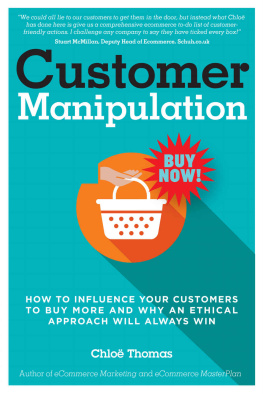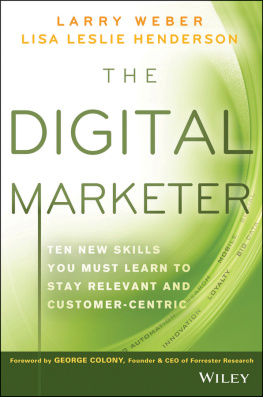
Contents
Pages
Guide
BUILD FOR CHANGE
REVOLUTIONZING CUSTOMER ENGAGEMENT THROUGH CONTINUOUS DIGITAL INNOVATION
ALAN TREFLER
Cover image and design: Wiley
Copyright 2014 by Pegasystems, Inc. All rights reserved.
Published by John Wiley & Sons, Inc., Hoboken, New Jersey.
Published simultaneously in Canada.
No part of this publication may be reproduced, stored in a retrieval system, or transmitted in any form or by any means, electronic, mechanical, photocopying, recording, scanning, or otherwise, except as permitted under Section 107 or 108 of the 1976 United States Copyright Act, without either the prior written permission of the Publisher, or authorization through payment of the appropriate per-copy fee to the Copyright Clearance Center, 222 Rosewood Drive, Danvers, MA 01923, (978) 750-8400, fax (978) 646-8600, or on the web at www.copyright.com. Requests to the Publisher for permission should be addressed to the Permissions Department, John Wiley & Sons, Inc., 111 River Street, Hoboken, NJ 07030, (201) 748-6011, fax (201) 748-6008, or online at www.wiley.com/go/permissions.
Limit of Liability/Disclaimer of Warranty: While the publisher and author have used their best efforts in preparing this book, they make no representations or warranties with the respect to the accuracy or completeness of the contents of this book and specifically disclaim any implied warranties of merchantability or fitness for a particular purpose. No warranty may be created or extended by sales representatives or written sales materials. The advice and strategies contained herein may not be suitable for your situation. You should consult with a professional where appropriate. Neither the publisher nor the author shall be liable for damages arising herefrom.
For general information about our other products and services, please contact our Customer Care Department within the United States at (800) 762-2974, outside the United States at (317) 572-3993 or fax (317) 572-4002.
Wiley publishes in a variety of print and electronic formats and by print-on-demand. Some material included with standard print versions of this book may not be included in e-books or in print-on-demand. If this book refers to media such as a CD or DVD that is not included in the version you purchased, you may download this material at http://booksupport.wiley.com. For more information about Wiley products, visit www.wiley.com.
ISBN: 978-1-118-93026-7 (cloth)
ISBN: 978-1-118-93028-1 (ebk)
ISBN: 978-1-118-893029-8 (ebk)
Foreword
So much has changed in the business world, particularly in the past 20 years. Two changes are particularly relevant to this book. First, thanks to the ubiquity of technology and the reach of the Internet, the power of customers has reached dramatic levels. You will see many examples of this phenomenon in the pages ahead. Second, companies can now fully digitize their processes to the point where the enterprise can and must undergo a full digital transformation. It is the only way the enterprise will accomplish the seamless operations so vital to success. But as this happens, the enterprise must focus on how, through both high tech and high touch, it engages customers and responds to their expectations.
This book lays out the path to accomplishing that result.
There will be several challenges along the way. Past approaches to systems development have left companies frozen in technology, unable to respond to both opportunities and the demands of customers. Companies cannot solve this problem by simply buying apps or software as a service. Technology and process must be more tightly integrated in the work of digitization. That integration will require that the divide between the information technology (IT) and business communities goes away. As this happens, the organization itself will undergo change.
That change will include how people think of their own work: how work is performed and customers are engaged; the pace of work and the rate at which operational change can be accomplished; the ability to see how radically the performance of an enterprise can improve with the right approach to technology and process, as business and IT people come together to drive change.
Changes in thinking and behavior will not be restricted just to the workers. No great change is achieved unless an enterprises leaders and managers change how they think and behave. What has been the key to past success may not be the key to success in the future. That is especially true with respect to the role of information technology and how it is managed.
Twenty years ago, Michael Hammer and I published Reengineering the Corporation. We described the three Cscustomers, competition, and changeas the forces driving companies into frighteningly unfamiliar territory. New entrants to markets were intensifying competition by changing the rules of business, while the pace of business change itself was accelerating. Meanwhile, customers were gaining the upper hand in their relationships with sellers, with access to more information and more choice, and were becoming increasingly sophisticated and demanding.
In some respects, what we wrote was seen as predictive. All this was happening while companies were stuck in their bureaucratic structures and fragmented work. Meanwhile, customers in particular were beginning to drive the need for change. We wrote that business customers and individual consumers know what they want, what they want to pay for it, and how to get it on the terms they demand. We warned that customers such as these dont need to deal with companies that dont understand and appreciate this startling change in the customer-seller relationship. Customers will just go elsewhere.
Today, customers are doing just that.
We argued for radical change in the nature of work, with a focus on the redesign of business processes. Today, the phenomena we described are plain to see, and drive the urgency of what you will read in this book.
The cry for leaders and managers to wake up to the changing business landscape and the importance and power of technology is not new. I have made the plea and have heard it for years. But what is new is the approach to the digitization of the enterprise that this book lays out. Time is of the essence. While customers have been gaining power, the pace of business change is also accelerating. It is time to think radically about how technology plays and works in your enterprise.
James Champy
Coauthor of Reengineering the Corporation;
Author of X-Engineering the Corporation:
Reinventing Your Business in the Digital Age
Acknowledgments
This book is the product of decades of engagement with many of the worlds most sophisticated organizations. I would like to thank the clients who have shared their views on the imminent threats, as well as their managerial and technological responses. Their journeys are the real story of this book, and it has been a privilege to see firsthand how insight and innovation can lead to differentiated success.
Capturing and refining these ideas has been a journey in itself. Let me thank the team of Brian Callahan, Scott Cooper, and Russell Keziere for invaluable assistance in getting to this point.
Thanks also to the Central Square Theater (www.centralsquaretheater.org) for organizing the focus group quoted in this book. This included cast members, aged 14 to 22, of
Next page








